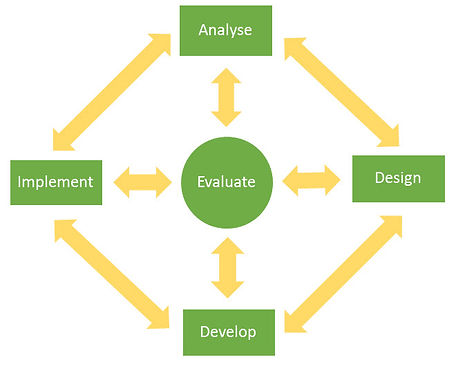The Develop Phase
When many people think of instructional design or creating learning content, it's the Development Phase that most associate with it. You've completed your analysis, created your Training Plan (and perhaps a Design Document, too!) and now you must go about creating your lesson. In your Training Plan, you listed the modality of your course (instructor-led, eLearning, blended, etc.). The type of deliverable you choose will impact what tools you will want to consider when building your course.
Both instructor-led training (ILT) and eLearning/web-based training (WBT) can benefit from audio/video components. Because these can be used in both, and because there are a number of inexpensive or free video editors available, we will consider which of these to use is beyond the scope of this website. Suffice to say that if audio/video will be a part of your course, you should either use software with which you are comfortable or partner with someone who has experience in video creation and editing. Videos do not have to be polished and perfect for learning to happen (just look at all the YouTube videos people use millions of times a day to learn a new skill!) but there are a few nuances to video production that can make or break your learner's attention.
Okay, let's do a brief overview of tools used by instructional designers, separated into two categories: Instructor-led training (ILT) tools, and eLearning/web-based training (WBT) tools. Note that we cover the eLearning tools in more detail under the eLearning Dev Tools Tab in the top toolbar.
Instructor-led Training Development Tools
Probably the most recognizable and user-friendly of the ILT development tools are Microsoft Word and PowerPoint. Both have free templates libraries available to provide a custom look and feel to your content, and both have very robust review/feedback capabilities. While some designers (myself included) have used Microsoft PowerPoint to create Leader or Learner Guides, I would not recommend it. PowerPoint is at it's best when supporting visual content, like when displayed as an overhead projection. You'll soon find Word is a far more efficient option to develop guides, especially once you get a favorite template!
Adobe Acrobat Pro allows you to draft, edit, and add security to .PDF documents. If you only have the free Acrobat Reader, you've likely noticed that .PDF documents cannot be edited. Adobe Acrobat Pro allows you to edit PDFs (provided you have any required passwords for the document). This is especially helpful when you do not want any end-users to make changes to your Word document to keep the content consistent. Acrobat Pro also has a great feature which lets you take multiple .PDF documents and combine them all into a single book.
Adobe Framemaker is a very different type of development software, and it's primary purpose is to support what is known as structured content. "A structured content environment also referred to as a Component Content Management System (CCMS), allows organizations to easily create, reuse, share, search, translate, and deliver content to any channel or AI-device or application, avoiding duplicate content and inconsistencies that can impact the productivity" (Maity, A. 2019. p1.).
When you author in a structured content development tool, you can assign all sorts of rules to content containers (from the entire lesson to a single paragraph or word). For example, in the sentence "Tech support users will not use this new flow" you could highlight the sentence and create a condition such as "Tech Support Audience Only." When you go to publish the document, and you choose Tech Support as the audience, this sentence will display in the course. If you choose a different audience, say Collections Audience, the sentence will be removed when published. Cool, right?
Also, structured content alleviates much of the time ID's spend on formatting fonts, colors, alignment, and the like. Whoever creates the style rules, selects all of the fonts, fonts sizes, colors, and styles that will display for all of the courses. The plus side of this is a consistent look/feel and allows you to focus on just the content. The downside is that each lesson tends to look the same. The bottom line is that structured content design tools are likely overkill for the novice instructional designer, or even seasoned instructional designers who work on smaller, unrelated projects where sharing content across multiple audiences is not required.
While the primary focus of this website is on eLearning creation, it's helpful to know what tools are out there in use for traditional classroom approaches. Instructor-led Training (ILT) development tools come in a wide variety of platforms, and some can be very unique in their abilities. Whether the goal is to create paper-based deliverables (Instructor Guide, Learner Guide, etc.), or digital ones, there are a number of excellent tools available to choose from depending on your needs and budget. Here are four very common ILT development tools in the training industry:

Photo Courtesy of Wix.com
eLearning/web-based Training Development Tools
All right, on to the tools commonly used in the development of eLearning! Again, there are a number of different development platforms available. Some are better-suited to some learning interactions, and some to others. Four of the most common eLearning development tools are:
-
Lectora (Trivantis)

Photo Courtesy of Wix.com
Adobe Captivate and Camtasia are preferred by many IDs for the ease of which videos and screen recordings can be leveraged to create learning. They provide quick and easy ways to allow the learner to observe step actions recorded on screens, then attempt to replicate the steps with assistance, and finally assess their ability to replicate them without assistance. Articulate360 and Lectora (now called Trivantis) are full-feature eLearning development tools that support just about anything you as the instructional designer dreams up. With a similar feel to Microsoft PowerPoint, they both use "slides" as each new learning screen. Animations, videos, audio, and activities can all be customized through the use of layers and logic triggers. These are just a few of the tools available. There is an excellent article by Learnupon.com which provides a brief review and links to what they consider are the top 20 eLearning development tools of 2020 (McGarry, 2019).
eLearning Terms to Know
Learning Management System (LMS)
An LMS is specialized software that allows an organization to deliver and track online training activities (Pappas, 2017).
In most cases, an LMS will require a course be converted to a SCORM file to assign, deliver, and track the course.
SCORM
Sharable Content Object Reference Model
"It is a set of technical standards for eLearning software products" (SCORM, 2020. p.1).
It is the industry-standard output format in which Learning Management Systems and online learning content can communicate with one another (SCORM, 2020).
Note: All four of the eLearning development tools listed earlier support SCORM file output.
Let's Talk Review Cycles...
As mentioned in the ADDIE overview page on this site, the model is not completely linear. There are times when it's appropriate to revisit a different phase to course correct or to give stakeholders and project partners vision into what you are creating. This is especially true in the Development Phase and comes in the form of project reviews. Think back to the Training Plan we discussed in the Design Phase. Remember the work-back schedule? It included several reviews at various stages in the process.
Reviews are a necessary part of the instructional design process. They allow stakeholders, subject matter experts, and any other project team members to provide feedback. That feedback is a gift! As RussellMartin says "Bad news early is good news" (n.d., p.1). You may have thought that your first draft of the course was perfect - it contained no grammatical or punctuation errors, and you explained the content to perfection. When you receive feedback during the reviews, you realize it wasn't as perfect as you originally thought. And that is OK! We're all human, and we're bound to miss an apostrophe here or there. We may discover that our carefully worded instructions weren't so clear after all. Or, we may even find our understanding and explanation of a process is not correct according to an expert.
The bottom line is, reviews need to happen to ensure a professional, accurate product. And in keeping with Russell Martin's advice, the sooner the better. Remember this graphic from earlier?

Image courtesy of TheLearningTree.com
ADDIE is not a linear process. At each step of the way, you should review (evaluate) your approach to make sure it's the right approach. You design your Training Plan, it should be reviewed, updated, and approved before moving into Development. Once your first draft is developed, it should go out for a review. Once feedback is received and your draft is updated, it should go through additional reviews as needed. Some of the most common reviews are:
-
Desktop Publishing (DTP): Checks for grammar, punctuation, and style-guide adherence
-
Legal: Checks for any content which could pose a legal risk to the organization
-
End-user (or focus group): Checks usability and viability with a small number of the intended audience
-
Final: Provides one last review and approval touchpoint before the content is published.
How well do you know Review Cycles? How about an ADDIE-tude check with a quick and easy drag-and-drop activity below? Don't worry, you can take it as many times as you like!
Resources
Maity, A. (2019). 6 Features You Need in a Structured Content Authoring Tool. SDL Foundation. https://blog.sdl.com/blog/Six-Features-You-Need-in-Structured-Content-Authoring-Solution.html
McGarry, O. (2019). The Top 12 eLearning Authoring Tools (2020 Update). LearnUpon. https://www.learnupon.com/blog/top-authoring-tools-elearning/
Pappas, C. (2017). What is a Learning Management System? LMS Basic Function and Features You Must Know. eLearning Industry. https://elearningindustry.com/what-is-an-lms-learning-management-system-basic-functions-features
Russellmartin.com. (n.d.). Bad News Early is Good News. http://www.russellmartin.com/leadership.html


